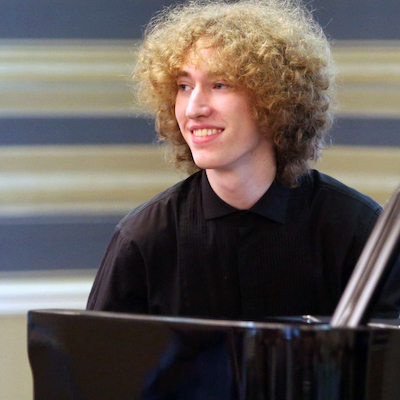“Goyescas” by Enrique Granados is a collection of piano pieces inspired by the paintings of Francisco Goya. The suite portrays the lives and passions of the majos, dashing folk of 18th-century Madrid who distinguished themselves by their exaggerated outfits and elaborate style in dress and manners. American Pianists Awards finalist Michael Davidman offers his thoughts on the piece to accompany his performance in this special edition of Five Things.
“Goyescas” by Enrique Granados is a collection of piano pieces inspired by the paintings of Francisco Goya. The suite portrays the lives and passions of the majos, dashing folk of 18th-century Madrid who distinguished themselves by their exaggerated outfits and elaborate style in dress and manners.
American Pianists Awards finalist Michael Davidman performed selections from the suite in the 2021 competition. After finishing his Master of Music degree at the Juilliard School with Jerome Lowenthal and Stephen Hough, Michael is pursuing an Artist Diploma studying with Stanislav Ioudenich at the International Center for Music (ICM), Kansas City, MO.

Ahead of a scheduled performance of “Goyescas” in Spain in July 2023, Michael shared why it is one of his favorite works as a preface to another edition of Five Things.
MICHAEL:
The Goyescas, Op. 11 (1911) by Enrique Granados is one of my favorite works for the piano. I find it to be one of the most beautiful artistic creations from the pre-WWI era, and a totally unique work in piano literature.
The pieces in the set each bear a descriptive title and are linked together by the main subtitle: “Los majos enamorados”, or the majos in love. Majos, as depicted in the paintings of Goya, were essentially the bohemians of 18th century Madrid. The pieces in the set do not necessarily refer to specific works by Goya but are instead an evocation of the world which is depicted in many of his drawings. Granados follows the majos enamorados from their first meeting in “Los Requiebros” (the compliments, or flirtations) to a secret confession of love through a window grill in “Coloquio en la Reja,” to a dance at a tavern by candlelight (“El Fandango de Candil”).
The 4th piece of the set, “Quejas, o la Maja y el Ruiseñor” (Laments, or the Maja and the nightingale) is the most well-known and often performed. It depicts the separation of the lovers, and the longing of the maja. She is joined in her garden by a nightingale, sympathetic to her lamentations. This leads into the 5th piece, “El Amor y la Muerte: Balada” (Love and Death: Ballade), which depicts the death of the majo, probably after a duel, while his beloved, despairing and helpless, looks on. The last piece is an epilogue, titled “Serenata del Espectro” (ghostly serenade). The ghost of the majo strums his guitar melancholically near his desolate grave, bells chime in the distance, and he fades into nothingness with a last, ironic pluck of the open strings.
I love performing the Goyescas because they allow me to identify with an area of my poetic imagination that I don’t get to explore as vividly, or I should say, as freely, in many other works. In addition to this, its numerous and unique technical difficulties and advanced musical content make the Goyescas a work which requires complete commitment from the pianist in all areas of their craft.
With Michael’s enthusiasm for the piece paramount in mind, here are five things to listen for in his performance:
Spanish Folk Influence: The Goyescas are heavily influenced by Spanish dance forms. Listen for a variety of rhythmic patterns and, particularly, the use of syncopation (accenting off-beats) that gives the music its spirited and dance-like qualities. The distinct Spanish flair is reminiscent of flamenco, fandangos and other traditional Spanish dances.
Emotional Arc: Notice the emotional journey of the lovers inspired by Goya’s paintings and the lives of the majos in scenes depicted in the music. From the initial flirtations in "Los Requiebros," to the intense emotions during the separation of the lovers in "Quejas, o la Maja y el Ruiseñor," to the tragic climax in "El Amor y la Muerte: Balada," observe how Granados uses dynamics, tempo and harmony to convey a narrative arc.
Technical Challenges: The Goyescas are demanding in terms of finger dexterity, control and expressiveness. Critic Orrin Howard notes “there are sections whose intricacies seem to demand at least four hands, or more.”
Form and Thematic Development: Pay attention to how Granados structures each piece within the suite. Each one is a self-contained composition, but all are thematically and harmonically connected to form a coherent whole. Listen for recurring themes and motifs and how Granados develops and varies them across the different pieces.
Texture and Voicing: Note the textural elements in Goyescas, ranging from delicate, intricate passages to thick, lush chords. Listen to how Granados uses multiple voices within the piano writing, often with independent melodic lines. This is especially evident in the interplay between the right and left hands, mimicking conversations or duets.
Goyescas is Granados’ most famous piece and to many, also his finest. Please enjoy Michael Davidman’s performance and let us know what you think!
---
